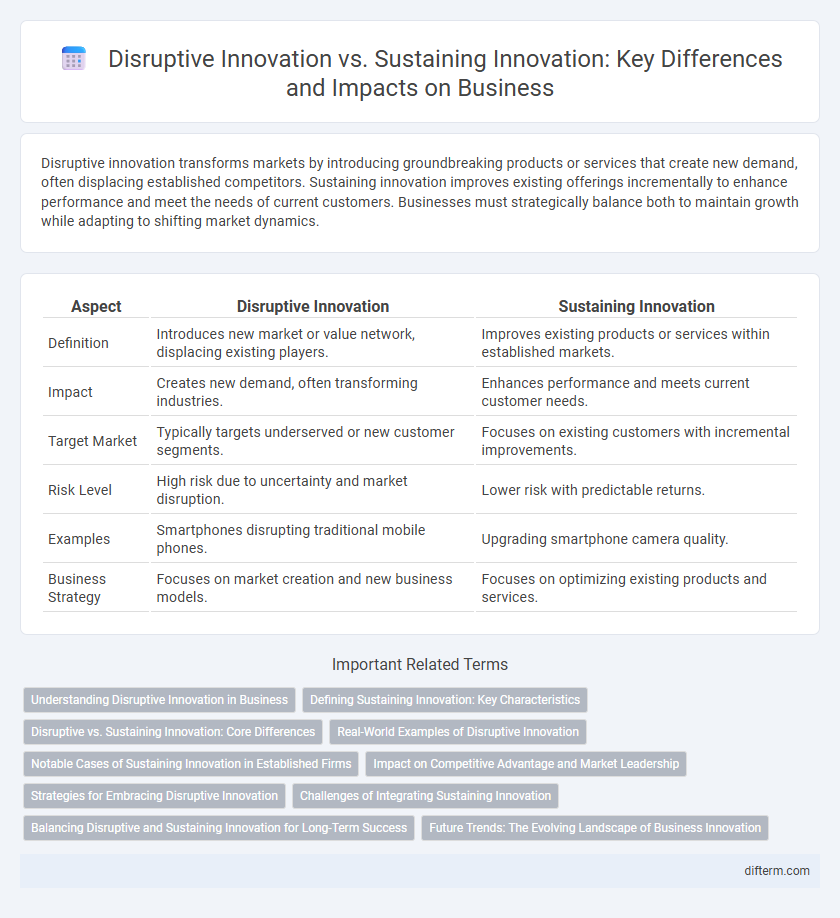Disruptive innovation transforms markets by introducing groundbreaking products or services that create new demand, often displacing established competitors. Sustaining innovation improves existing offerings incrementally to enhance performance and meet the needs of current customers. Businesses must strategically balance both to maintain growth while adapting to shifting market dynamics.
Table of Comparison
| Aspect | Disruptive Innovation | Sustaining Innovation |
|---|---|---|
| Definition | Introduces new market or value network, displacing existing players. | Improves existing products or services within established markets. |
| Impact | Creates new demand, often transforming industries. | Enhances performance and meets current customer needs. |
| Target Market | Typically targets underserved or new customer segments. | Focuses on existing customers with incremental improvements. |
| Risk Level | High risk due to uncertainty and market disruption. | Lower risk with predictable returns. |
| Examples | Smartphones disrupting traditional mobile phones. | Upgrading smartphone camera quality. |
| Business Strategy | Focuses on market creation and new business models. | Focuses on optimizing existing products and services. |
Understanding Disruptive Innovation in Business
Disruptive innovation in business transforms markets by introducing products or services that initially target underserved or niche segments, eventually displacing established competitors. Unlike sustaining innovation, which improves existing offerings for current customers, disruptive innovation creates new value networks and reshapes industry dynamics. Understanding this distinction enables companies to anticipate market shifts and invest strategically in breakthrough technologies.
Defining Sustaining Innovation: Key Characteristics
Sustaining innovation focuses on improving existing products or services within established markets by enhancing performance, reliability, or features to meet evolving customer needs. It typically involves incremental advancements that do not fundamentally change market dynamics but help companies maintain competitive advantage and profitability. Companies like Toyota exemplify sustaining innovation by continuously refining hybrid technology without altering core market structures.
Disruptive vs. Sustaining Innovation: Core Differences
Disruptive innovation introduces groundbreaking products or services that create new markets by targeting underserved customers, often reshaping industries. Sustaining innovation focuses on improving existing products and services to better meet the demands of current customers. Core differences include market impact, customer focus, and the nature of technological change, where disruptive innovation challenges market leaders, while sustaining innovation reinforces their position.
Real-World Examples of Disruptive Innovation
Netflix transformed the entertainment industry by shifting from DVD rentals to streaming, disrupting traditional cable and rental businesses. Airbnb revolutionized hospitality by enabling peer-to-peer lodging, challenging established hotel chains worldwide. Tesla accelerated the electric vehicle market, leveraging advanced battery technology to disrupt conventional automotive manufacturers.
Notable Cases of Sustaining Innovation in Established Firms
Established firms like Apple and Toyota exemplify sustaining innovation by continuously enhancing existing products and processes to maintain market leadership. Apple's iterative improvements to the iPhone, such as camera upgrades and system optimization, showcase how sustaining innovation drives customer loyalty and revenue growth. Toyota's refinement of hybrid technology in the Prius highlights sustained enhancements that improve performance, efficiency, and environmental impact without upending current market structures.
Impact on Competitive Advantage and Market Leadership
Disruptive innovation reshapes markets by introducing groundbreaking products or services that redefine consumer expectations, enabling companies to gain substantial competitive advantage and eventually dominate new or existing market segments. In contrast, sustaining innovation improves existing products or processes, helping established firms maintain their market leadership and defend market share against rivals. Firms that balance both innovation types effectively secure long-term growth and fortify their positions as market leaders.
Strategies for Embracing Disruptive Innovation
Companies embracing disruptive innovation prioritize agile strategies, such as investing in emerging technologies and cultivating a culture of experimentation to challenge existing market paradigms. Implementing dedicated teams focused on developing breakthrough products enables rapid adaptation to shifting consumer demands and competitive landscapes. Leveraging customer insights and strategic partnerships enhances the ability to identify untapped opportunities and scale innovative solutions effectively.
Challenges of Integrating Sustaining Innovation
Sustaining innovation faces challenges including high development costs, limited market differentiation, and resistance from established customers expecting incremental improvements. Integrating sustaining innovation requires balancing existing product performance with new features without alienating the core user base or cannibalizing current revenue streams. Organizations must manage complex legacy systems and internal processes that often slow down the implementation of sustaining innovations.
Balancing Disruptive and Sustaining Innovation for Long-Term Success
Balancing disruptive innovation with sustaining innovation is essential for long-term business success, as disruptive innovations create new markets while sustaining innovations improve existing products and services. Companies that strategically allocate resources to both innovation types can maintain competitive advantage and adapt to evolving consumer demands. Integrating data-driven insights and agile methodologies ensures continuous growth and resilience in dynamic market landscapes.
Future Trends: The Evolving Landscape of Business Innovation
Disruptive innovation reshapes entire industries by introducing groundbreaking products or services that create new markets, while sustaining innovation improves existing offerings to maintain competitive advantage. Future trends indicate a growing emphasis on integrating artificial intelligence, blockchain, and quantum computing as catalysts for both types of innovation, driving accelerated business transformation. Companies prioritizing agile strategies and investment in emerging technologies will lead the evolving landscape of business innovation.
disruptive innovation vs sustaining innovation Infographic

 difterm.com
difterm.com